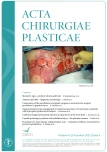Otrava kyanidem u pacientů s inhalačním poraněním – skrytá hrozba
Autoři:
Raška F. 1; Lipový B. 1,2; Hladík M. 1; Holoubek J. 1
Působiště autorů:
Department of Burns and Plastic Surgery, University Hospital Brno, Faculty of Medicine, Masaryk University, Brno, Czech Republic
1; CEITEC – Central European Institute of Technology, University of Technology, Brno, Czech Republic
2
Vyšlo v časopise:
ACTA CHIRURGIAE PLASTICAE, 63, 4, 2021, pp. 185-189
doi:
https://doi.org/10.48095/ccachp2021185
Zdroje
1. Mlcak RP., Suman OE., Herndon DN. Respiratory management of inhalation injury. Burns 2007, 33(1): 2–13.
2. Symington IS., Anderson RA., Thomson I., et al. Cyanide exposure in fires. Lancet 1978, 2(8080): 91–92.
3. MacLennan L., Moiemen N. Management of cyanide toxicity in patients with burns. Burns 2015, 41(1): 18–24.
4. Hall AH., Rumack BH. Clinical toxicology of cyanide. Ann Emerg Med. 1986, 15(9): 1067–1074.
5. Curry SC., LoVecchio FA. Hydrogen cyanide and inorganic cyanide salts. In: Sullivan JB., Krieger GR. (eds). Clinical environmental health and toxic exposures. Philadelphia: Lippincott Williams & Wilkins 2001, 705–716.
6. Kerns W., Isom G., Kirk MA. Cyanide and hydrogen sulfide. In: Goldfrank LR., Flomenbaum NE., Lewin NA., et al. (eds). Goldfrank´s toxicologic emergencies. New York: McGraw-Hill 2002, 1498–1510.
7. Baud FJ., Barriot P., Toffis V., et al. Elevated blood cyanide concentrations in victims of smoke inhalation. N Engl J Med. 1991, 325(25): 1761–1766.
8. Kulig K., Ballantyne B. Case studies in environmental medicine: cyanide toxicity. Agency Toxic Subst Dis Regist US Dep Health Hum Serv. Atlanta GA 1991.
9. Šín P., Hokynková A., Rotschein P., et al. Reconstruction of deep head burn with a free flap – a case report. Acta Chir Plast. 2020, 61(1–4): 32–35.
10. Morocco AP. Cyanides. Crit Care Clin. 2005, 21(4): 691–705.
11. Lawson-Smith P., Olsen NV., Hyldegaard O. Hyperbaric oxygen therapy or hydroxycobalamin attenuates surges in brain interstitial lactate and glucose; and hyperbaric oxygen improves respiratory status in cyanide-intoxicated rats. Undersea Hyperb Med. 2011, 38(4): 223–237.
12. Hart GB., Strauss MB., Lennon PA., et al. Treatment of smoke inhalation by hyperbaric oxygen. J Emerg Med. 1985, 3(3): 211–215.
13. Way JL., End E., Sheehy MH., et al. Effect of oxygen on cyanide intoxication. IV. Hyperbaric oxygen. Toxicol Appl Pharmacol. 1972, 22(3): 415–421.
14. Mégarbane B., Delahaye A., Goldgran-Tolédano D., et al. Antidotal treatment of cyanide poisoning. J Chin Med Assoc. 2003, 66(4): 193–203.
15. Uhl W., Nolting A., Golor G., et al. Safety of hydroxocobalamin in healthy volunteers in a randomized, placebo-controlled study. Clin Toxicol (Phila). 2006, 44(Suppl 1): 17–28.
16. Hillman B., Bardhan KD., Bain JTB. The use of dicobalt edetate (Kelocyanor) in cyanide poisoning. Postgrad Med J. 1974, 50(581): 171–174.
17. Hall AH., Saiers J., Baud F. Which cyanide antidote? Crit Rev Toxicol. 2009, 39(7): 541–552.
18. Reade MC., Davies SR., Morley PT., et al. Review article: management of cyanide poisoning. Emerg Med Australas. 2012, 24(3): 225–238.
19. van Heijst AN., Douze JM., van Kesteren RG., et al. Therapeutic problems in cyanide poisoning. J Toxicol Clin Toxicol. 1987, 25(5): 383–398.
20. Bhattacharya R., Flora SJS. Cyanide toxicity and its treatment. In: Gupta RC. (eds). Handbook of toxicology of chemical warfare agents. Boston: Academic Press 2015, 301–314.
21. Hall AH., Kulig KW., Rumack BH. Suspected cyanide poisoning in smoke inhalation: complications of sodium nitrite therapy. J Toxicol Clin Exp. 1989, 9(1): 3–9.
22. Bebarta VS., Tanen DA., Lairet J., et al. Hydroxocobalamin and sodium thiosulfate versus sodium nitrite and sodium thiosulfate in the treatment of acute cyanide toxicity in a swine (Sus scrofa) model. Ann Emerg Med. 2010, 55(4): 345–351.
23. Bebarta VS., Pitotti RL., Dixon P., et al. Hydroxocobalamin versus sodium thiosulfate for the treatment of acute cyanide toxicity in a swine (Sus scrofa) model. Ann Emerg Med. 2012, 59(6): 532–539.
24. Hall AH., Dart R., Bogdan G. Sodium thiosulfate or hydroxocobalamin for the empiric treatment of cyanide poisoning? Ann Emerg Med. 2007, 49(6): 806–813.
Štítky
Chirurgie plastická Ortopedie Popáleninová medicína TraumatologieČlánek vyšel v časopise
Acta chirurgiae plasticae

2021 Číslo 4
- Metamizol jako analgetikum první volby: kdy, pro koho, jak a proč?
- MUDr. Lenka Klimešová: Multioborová vizita může být klíčem k efektivnější perioperační léčbě chronické bolesti
- Léčba akutní pooperační bolesti z pohledu ortopeda
- Neodolpasse je bezpečný přípravek v krátkodobé léčbě bolesti
Nejčtenější v tomto čísle
- Frontálně otevřený skus – diagnostika a léčba
- Léčba hypertrofických jizev frakčním CO2 laserem – hodnocení účinnosti a optimalizace léčebného protokolu
- Otrava kyanidem u pacientů s inhalačním poraněním – skrytá hrozba
- Moriartyho znamení – prediktor přihojení kožního štěpu
